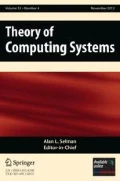Abstract
The problem of choosing a “best” program for a function presented by example is considered. General axioms for total complexity involving time and size measures are presented. For measures obeying the axioms, certain positive and negative results are obtained on the existence of effective algorithms for learning the best program.
Similar content being viewed by others
References
Biermann, A., On the inference of Turing Machines from sample computations, CS241, Stanford Computer Science Department, October 1971.
Biermann, A. andJ. Feldman, A survey of grammatical inference, in S. Watanabe (Ed.)Frontiers of Pattern Recognition.
Blum, L. andM. Blum, Inductive inference: A recursion theoretic approach, 14th Annual Symposium on Switching and Automata Theory, IEEE October 1973, pp. 200–208.
Blum, M., A machine-independent theory of the complexity of recursive functions,J. ACM 14 (1967), 322–336.
Blum, M., On the size of machines,Information and Control 11 (1967), 257–265.
Buchanan, B., E. Feigenbaum, andJ. Lederberg, A heuristic programming study of theory formation in science, Proc. 2nd ICJAI, London, 1971.
Chaitin, G. J., A theory of program size formally identical to information theory, RC 4805, IBM T. J. Watson Research Center, April 11, 1974.
Feldman, J. A., Automatic programming, CS255, Stanford University, February 1972.
Feldman, J. A., Some decidability results on grammatical inference and complexity,Information and Control, 1972.
Feldman, J. A., J. Gips, J. J. Horning andS. Reder, Grammatical inference and complexity, CS125, Stanford University, June 1969.
Fu, K. S., On syntactic pattern recognition and stochastic languages, TR-EE71-21, Purdue University, 1971.
Gold, M., Language identification in the limit,Information and Control 10 (1967), 447–474.
Gold, M., Limiting recursion,J. Symb. Logic 30 (1965), 28–48.
Hartmanis, J. andJ. Hopcroft, An overview of computational complexity,J. ACM 18 (1971), 444–475.
Hopcroft, J. E. andJ. D. Ullman,Formal Languages and Their Relation to Automata, Addison-Wesley, Reading, Mass., 1969.
Klein, S. et al., The autoling system, TR 43, Computer Science, University of Wisconsin, September 1968.
Meyer, A. R. andD. M. Ritchie, The complexity of loop programs, Proc. ACM 22nd Nat. Conf., pp. 465–9.
Pager, D., On the efficiency of algorithms,J. ACM 17 (1970), 708–715.
Plotkin, G. D., Automatic methods of inductive inference, Ph.D. thesis, Machine Intelligence Dept., University of Edinburgh, 1971.
Rogers, H., Jr.,Recursive Functions and Effective Computability, McGraw-Hill, New York, 1967.
Simon, H., Experiments with a heuritic compiler,J. Acm 10 (1963), 482–506.
Author information
Authors and Affiliations
Rights and permissions
About this article
Cite this article
Feldman, J.A., Shields, P.C. Total complexity and the inference of best programs. Math. Systems Theory 10, 181–191 (1976). https://doi.org/10.1007/BF01683271
Received:
Revised:
Accepted:
Issue Date:
DOI: https://doi.org/10.1007/BF01683271




